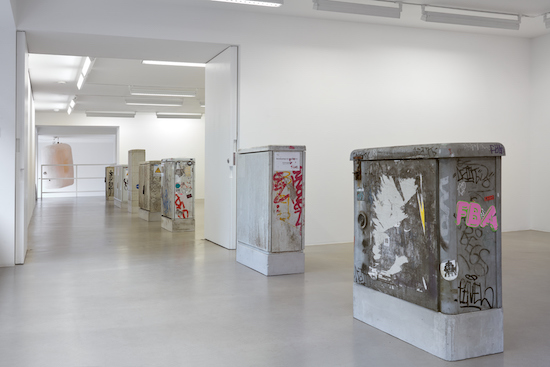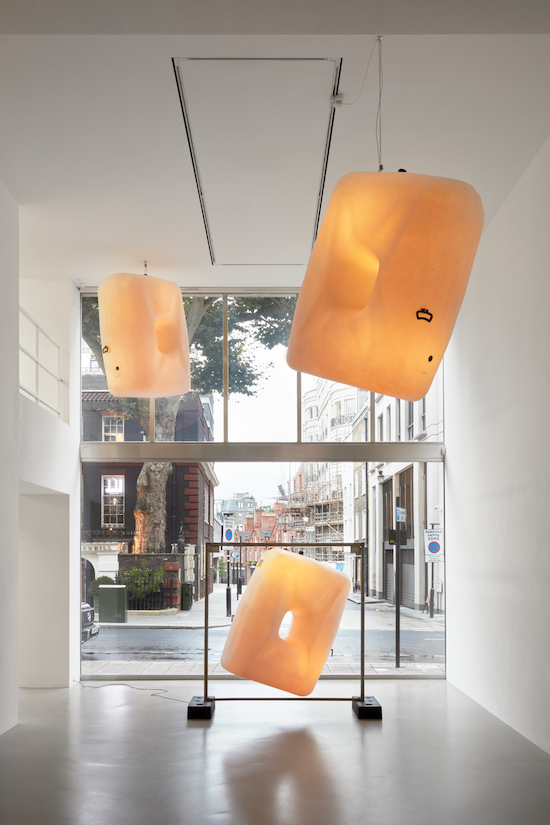Installation view, Klara Liden, Turn Me On, Sadie Coles HQ, London, 03 September – 24 October 2020. Credit: © Klara Liden, courtesy Sadie Coles HQ, London.Photo: Robert Glowacki
The city in the collective imagination is a bustling place of concrete, glass, metal, dirt and bodies. Klara Lidén’s work has always sought to make us question our perceptions of urbanism, how people live in the city. Her latest exhibition at Sadie Coles is no different. In Turn Me On, size and space are examined, the latter – unsurprisingly – partially in response to the pandemic. “I did think a little differently about the design of the show and tried to make it more visually and spatially accessible,” Lidén tells me over email.
The electric utility boxes that normally sit, unremarkable, at the end of the street, are lined up across the room like monuments not to the dead but to the living inhabitants of the city and their social disobedience: to their nicknames and cryptic tags, their spontaneous thoughts, their collectives and movements. Gathered together here in the gallery space, instead of streets apart from each other, they slough off mundaneness and instead their squareness, their dirt and dull colour acquire a curiousness.
That strangeness is also present in the ground floor space which presents three giant plastic tanks, the kind used to hold chemicals, illuminated from within. Lidén has enlarged them to the size you might see in a hyperrealistic sleep-paralysis-induced hallucination. Cirrocumulus (2020) is suspended high above the ground, Altocumulus (2020) at middling height, while Stratocumulus (2020) is suspended in a frame on ground level, reflecting the altitudes of the cloud namesakes.
The four-and-a-half-minute video projected on the wall, You’re all places that leave me breathless (2020) is also the stuff of nightmares. Playing on a loop, Lidén climbs through a cat’s cradle of scaffolding as the camera rotates. We do not know which way is up or down or left or right. As Lidén moves, we see great effort and concentration etched on her face – physically demanding and repetitive tasks are the Berlin and New York-based artist’s penchant – though, to what aim, we will never know. It begins in media-res: Lidén never enters or exits the space; there is no beginning or end to her Beckettian task either. Turn Me On, is the exhibition title, there appears to be no off-switch. This unnerving continuous action was the kernel out of which the exhibition grew. Lidén states, “I was trying to find a way to keep moving, not necessarily forward.”

Installation view, Klara Liden, Turn Me On, Sadie Coles HQ, London, 03 September – 24 October 2020. Credit: © Klara Liden, courtesy Sadie Coles HQ, London.Photo: Robert Glowacki
I think it would be redundant to say there might be a little bit of a metaphor for the slog of working life here. But with the COVID-19 pandemic forcing people and cities around the world out of work and in and out of lockdown, Lidén too was forced to consider her work and process. “Sometimes [creating the work in Berlin] felt hard, questioning the importance of my work, questioning my whereabouts. At some point, navigating the city with this new kind of loneliness drew my attention to the infrastructure, everything that made it possible for me to feel connected and less lost. This became the new starting point for the works in the exhibition.”
That sense of connection comes through in the illusion of the non-specificity of Lidén’s exhibits. It is only when you look closely at the plastic tanks, for example, and see the German writing that you realise they are specifically from Berlin, otherwise this exhibition seems to represent a kind of universal city. The commonalities between urbanites and their metropolises are expressed in the familiarity of the objects that dot the streets: the scaffolding, the plastic tanks, the utility boxes, the lichens that cover them as opposed to the more singular and iconic identifiers of the city, for example certain statues and skyscrapers.
“Considering the disarray of urban life right now, it certainly seems like a good time for us to find each other in some way,” says Lidén. That disarray is normally tempered by the many unspoken and unwritten rules that govern urban life. No contact with strangers. Keep one seat free between you on the subway.
Lidén’s work often displays the flouting of such social rules in public spaces. In 2004’s 550 Jamaica Avenue, Lidén breaks into the abandoned apartment above her New York flat. Her 2003 video work Paralyzed shows her dancing on a near-empty train in Stockholm with an enviable abandon. Such images resonate especially now as debates about personal freedom vs social responsibility rage and the city oscillates between being a place of potential liberation and potential harm.
If there is any specific time that throws that contradiction into sharp relief, it is night. In Greek mythology, Night is the daughter of Chaos. It is a time of conspiracy that encourages a kind of uninhibitedness less acceptable in the day. Lidén’s work often explores the strange limbo world. “The night has always been open and generous to me. It’s easier to be invisible in the dark,” she says. “I want that openness to be present in my work.” Her video The Myth of Progress (2008) sees her moonwalk at night through the empty streets of Manhattan. Her movements are slow and strange, and far more graceful than her clambering in Turn Me On but still no less strenuous. For all the iterations of the moonwalk out there, if there is one artist who truly understands the illusory aspect of the dance move – that one is supposed to move backwards while looking like they are moving forwards – it is Lidén in this video. You’re all places that leave me breathless seems to echo that idea of the myth of progress.
On her personal relationship with the city, Lidén tells me, “I really do enjoy stumbling on misplaced things and problems. Unexpected interruptions are humbling…” The openness of Turn Me On, the space and lightness are unexpected too, antithetical even. It is as though Lidén also seeks to disabuse us of our notions of city architecture in the gallery space, even as we think about city life outside of it. The artist is optimistic about what these reconsiderations could bring: “Sometimes good things turn out… I think that now, at a point in time when people are so worn down, that art could help create a larger sense of belonging and recognition in the world.”
Klara Lidén, Turn Me On, is at Sadie Coles HQ, Davies Street, London, until 24 October


